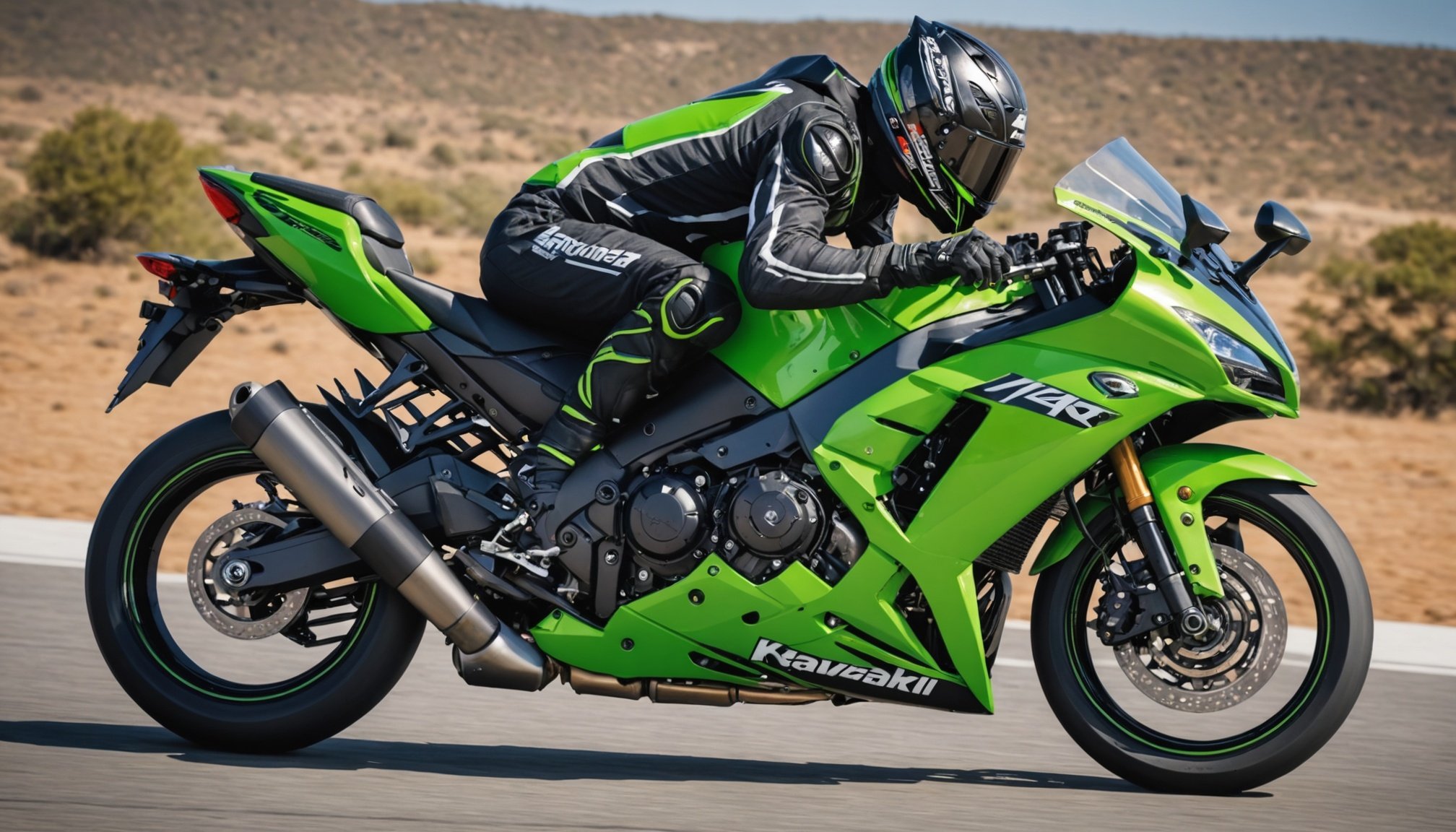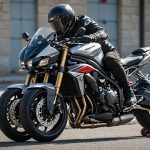Unlocking Peak ABS Efficiency for Your Kawasaki Ninja ZX-10R: 10 Essential Strategies
The Kawasaki Ninja ZX-10R is a powerhouse of a motorcycle, renowned for its exceptional performance and advanced technology. One of the key features that set it apart is its sophisticated Anti-lock Braking System (ABS), which is integral to enhancing safety and control. Here’s how you can unlock the peak efficiency of the ABS on your Kawasaki Ninja ZX-10R, along with other performance-enhancing strategies.
Understanding the ABS System
Before diving into the strategies, it’s crucial to understand the ABS system on your Kawasaki Ninja ZX-10R. The Kawasaki Intelligent anti-lock Brake System (KIBS) is designed to prevent the wheels from locking up during hard braking, ensuring better control and stability.
"The Kawasaki Intelligent anti-lock Brake System (KIBS) is a high-precision brake system designed to take into account the speed and slip rate of each wheel, as well as the motorcycle’s overall attitude and traction conditions"[1].
1. Proper Brake Pad Maintenance
The efficiency of your ABS system is heavily dependent on the condition of your brake pads. Worn-out brake pads can lead to reduced braking performance and inconsistent ABS operation.
- Regular Inspection: Check your brake pads every 1,000 to 3,000 miles, depending on your riding conditions.
- Replace When Necessary: Use high-quality brake pads specifically designed for your Kawasaki Ninja ZX-10R.
- Cleanliness: Ensure the brake calipers and rotors are clean and free from debris to maintain optimal braking performance.
2. Tire Pressure and Condition
Tire pressure and condition play a critical role in how your ABS system functions. Properly inflated tires with good tread depth ensure better traction and more accurate ABS operation.
Also to discover : Ultimate guide to preserving the radiance of your suzuki katana”s paint: expert tips for long-lasting shine
- Check Tire Pressure: Regularly check tire pressure according to the manufacturer’s recommendations.
- Tire Tread Depth: Ensure the tire tread depth is within the recommended limits.
- Tire Type: Use tires that are specifically designed for your Kawasaki Ninja ZX-10R, such as sport or track-focused tires.
3. Electronic Rider Aids
The Kawasaki Ninja ZX-10R comes equipped with a suite of electronic rider aids, including Sport-Kawasaki TRaction Control (S-KTRC) and Kawasaki Cornering Management Function (KCMF). These systems work in conjunction with the ABS to enhance overall control and stability.
“`quote
“The S-KTRC system helps to maximize acceleration on various types of road surfaces by predicting the slip of the rear wheel and acting before it actually happens”[1].
- Understand Each Mode: Familiarize yourself with the different modes of S-KTRC and KCMF to use them effectively in various riding conditions.
- Adjust Settings: Adjust the settings based on your riding style and the conditions you are riding in.
4. Brake Lever and Pedal Adjustment
Proper adjustment of the brake lever and pedal is crucial for optimal ABS performance. Ensure that the brake lever and pedal are adjusted to fit your riding position comfortably.
- Brake Lever Adjustment: Adjust the brake lever to a position where you can easily reach it without straining.
- Brake Pedal Adjustment: Adjust the brake pedal to a height where you can comfortably operate it with your foot.
5. Riding Techniques
Good riding techniques can significantly enhance the efficiency of your ABS system. Here are some tips:
- Smooth Braking: Apply the brakes smoothly and gradually, especially when entering corners.
- Weight Distribution: Maintain proper weight distribution on the bike to ensure even braking.
- Look Where You Want to Go: Keep your eyes focused on the path you want to take, which helps in maintaining control.
6. Regular ABS System Checks
Regular checks of the ABS system can help identify any issues before they become major problems.
- ABS Light: Check if the ABS light on your dashboard is illuminated. If it is, it could indicate a problem with the system.
- Sensor Cleaning: Clean the ABS sensors regularly to ensure they are functioning correctly.
- Professional Inspection: Have your ABS system inspected by a professional mechanic periodically.
7. Air Intake and Engine Performance
While the ABS system is primarily about braking, the overall performance of your engine can affect how the bike handles during braking. Here are some tips to optimize your engine performance:
- Air Intake: Ensure the air intake is clean and free from debris. Use a high-performance air filter if necessary.
- Engine Tuning: Keep your engine well-tuned. Regular servicing and tuning can ensure your engine is running at its best.
- Ram Air: The Kawasaki Ninja ZX-10R features a ram air system that enhances engine performance at high speeds. Ensure this system is functioning correctly.
8. Suspension Settings
The suspension settings of your bike can affect how it handles during braking. Here’s how you can optimize your suspension:
- Preload Adjustment: Adjust the preload to suit your weight and riding style.
- Damping Adjustment: Adjust the damping settings to match the riding conditions.
- Electronic Steering Damper: The Öhlins Electronic Steering Damper on the Kawasaki Ninja ZX-10R adjusts damping based on vehicle speed and acceleration. Ensure this system is functioning correctly.
9. Bodywork and Aerodynamics
The aerodynamics of your bike can affect its stability during high-speed braking. Here’s how the new bodywork on the Kawasaki Ninja ZX-10R helps:
- Integrated Winglets: The new bodywork features integrated winglets that improve downforce and reduce drag.
- Air-Cooled Oil Cooler: The air-cooled oil cooler enhances engine cooling, which is crucial during intense riding sessions.
10. Practice and Familiarization
Finally, practice and familiarization with your bike’s ABS system are key to unlocking its peak efficiency.
- Track Days: Participate in track days to get a feel for how the ABS system works under different conditions.
- Riding Courses: Take riding courses that focus on advanced braking techniques.
- Feedback from Other Riders: Join riding communities or forums to get feedback from other riders on how they optimize their ABS systems.
Comparative Analysis: Kawasaki Ninja ZX-10R vs Other High-Performance Bikes
Here’s a comparative analysis of the Kawasaki Ninja ZX-10R with other high-performance bikes in terms of ABS and overall performance:
| Feature | Kawasaki Ninja ZX-10R | Ducati Panigale V4 | BMW S1000RR | KTM RC 8C |
|---|---|---|---|---|
| Engine Displacement | 998cc | 1103cc | 999cc | 890cc |
| ABS System | KIBS | Bosch Cornering ABS | Dynamic Brake Light (DBL) | Cornering ABS |
| Traction Control | S-KTRC | Ducati Traction Control | Dynamic Traction Control | Motorcycle Traction Control |
| Frame | Aluminum Twin Spar | Aluminum alloy | Aluminum alloy | Steel trellis |
| Power | 203 HP | 214 HP | 207 HP | 128 HP |
| Price | $18,799 | $24,995 | $18,350 | $24,999 |
Practical Insights and Actionable Advice
Regular Maintenance
Regular maintenance is key to ensuring your ABS system functions at its best. Here are some actionable tips:
- Schedule Regular Servicing: Ensure your bike is serviced regularly according to the manufacturer’s schedule.
- Check Brake Fluid: Regularly check the brake fluid level and condition. Change it as recommended.
Riding in Different Conditions
Riding in different conditions requires adjustments to your ABS settings and riding techniques.
- Wet Conditions: Reduce your speed and use gentler braking in wet conditions.
- Track Riding: Use the track-specific modes of your S-KTRC and KCMF systems.
Upgrades and Accessories
While the Kawasaki Ninja ZX-10R comes with advanced features, there are still some upgrades and accessories you can consider to enhance performance:
- High-Performance Brake Pads: Upgrade to high-performance brake pads for better braking performance.
- Lightweight Wheels: Consider lightweight wheels to improve handling and braking.
In conclusion, unlocking the peak efficiency of the ABS system on your Kawasaki Ninja ZX-10R involves a combination of proper maintenance, understanding and utilizing the electronic rider aids, and practicing good riding techniques. By following these strategies, you can ensure your bike performs at its best, whether on the track or on the road.











